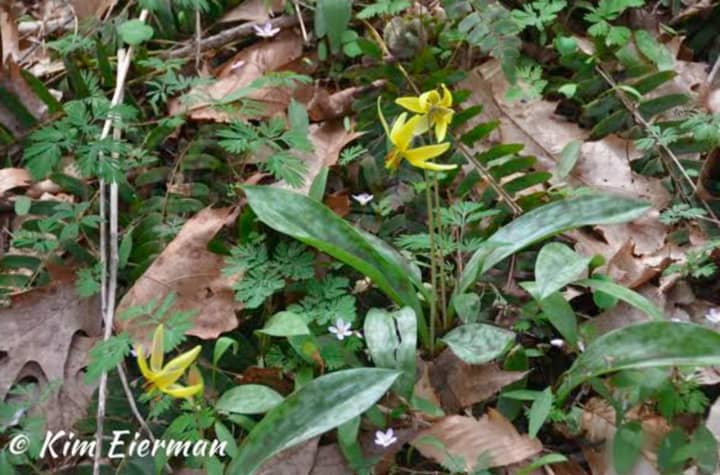As the name “ephemeral” implies, these small woodland charmers don’t last very long. They start to die back once trees leaf-out, although some ephemeral plants persist longer than others. Most spring ephemerals will disappear by summer, dying back into the ground, storing their energy for their next appearance in the following spring.
The transitory nature of spring ephemerals offers the opportunity to plant a later blooming plant in their vicinity, providing a sequence of bloom. Most spring ephemerals do best in a shady garden with dappled sunlight, where there is adequate moisture and well-drained, acidic soil. Make sure to leave the leaf litter in place for these plants, just as Mother Nature would in a forest setting.
If you want to help pollinators, consider that many spring ephemerals are important sources of nectar and/or pollen for early native pollinators. Give some of these native spring ephemerals a try:
Trout Lily (Erythronium americanum)
The odd name, Trout Lily, refers to the mottled pattern of the plant’s leaves that resembles trout. Often found in large colonies in moist areas, only the older plants with two leaves are capable of flowering. The result – beautiful, nodding yellow flowers reminiscent of small daylillies. Trout Lilies depend mostly on native bees for pollination.
Spring Beauty (Claytonia virginica)
This small plant often covers large areas at the edge of woodlands. Its grass-like leaves are the back-drop for charming small white blooms striped with pink. Pollinated mainly by small native bees, Spring Beauty supports a specialist pollinator, a type of mining bee, which depends upon the plant.
Dutchman’s Breeches (Dicentra cucullaria)
Another plant with a peculiar common name, Dutchman’s Breeches is so named for its flowers that resemble trousers worn by Dutch gentlemen many generations ago.
The billowy white flowers have yellow tips – targets for the native bees seeking nectar. Bumble bee queens are some of the primary pollinators, having evolved to emerge after winter when Dutchman’s Breeches comes into bloom. The white flowers often sport a pale pink hue.
Squirrel Corn (Dicentra canadensis)
A close relative of Dutchman’s Breeches, Squirrel Corn looks quite similar. Its leaves may have a bit more blue-green coloration and the leaves are more dissected. The white flowers of Squirrel corn lack the yellow tips next to the nectar source, and the top of the flowers (the spurs) are more rounded. Queen bumble bees also use the nectar of Squirrel Corn in early spring for a much needed source of energy. Some smaller native bees also benefit from this plant.
Stayed tuned for more suggestions of native spring ephemerals in part two of this article, coming soon.
Kim Eierman, a resident of Bronxville, is an environmental horticulturist and Founder of EcoBeneficial! When she is not speaking, writing, or consulting about ecological landscapes, she teaches at the New York Botanical Garden, Brooklyn Botanic Garden, The Native Plant Center and Rutgers Home Gardeners School.
Click here to follow Daily Voice Mt. Kisco and receive free news updates.


